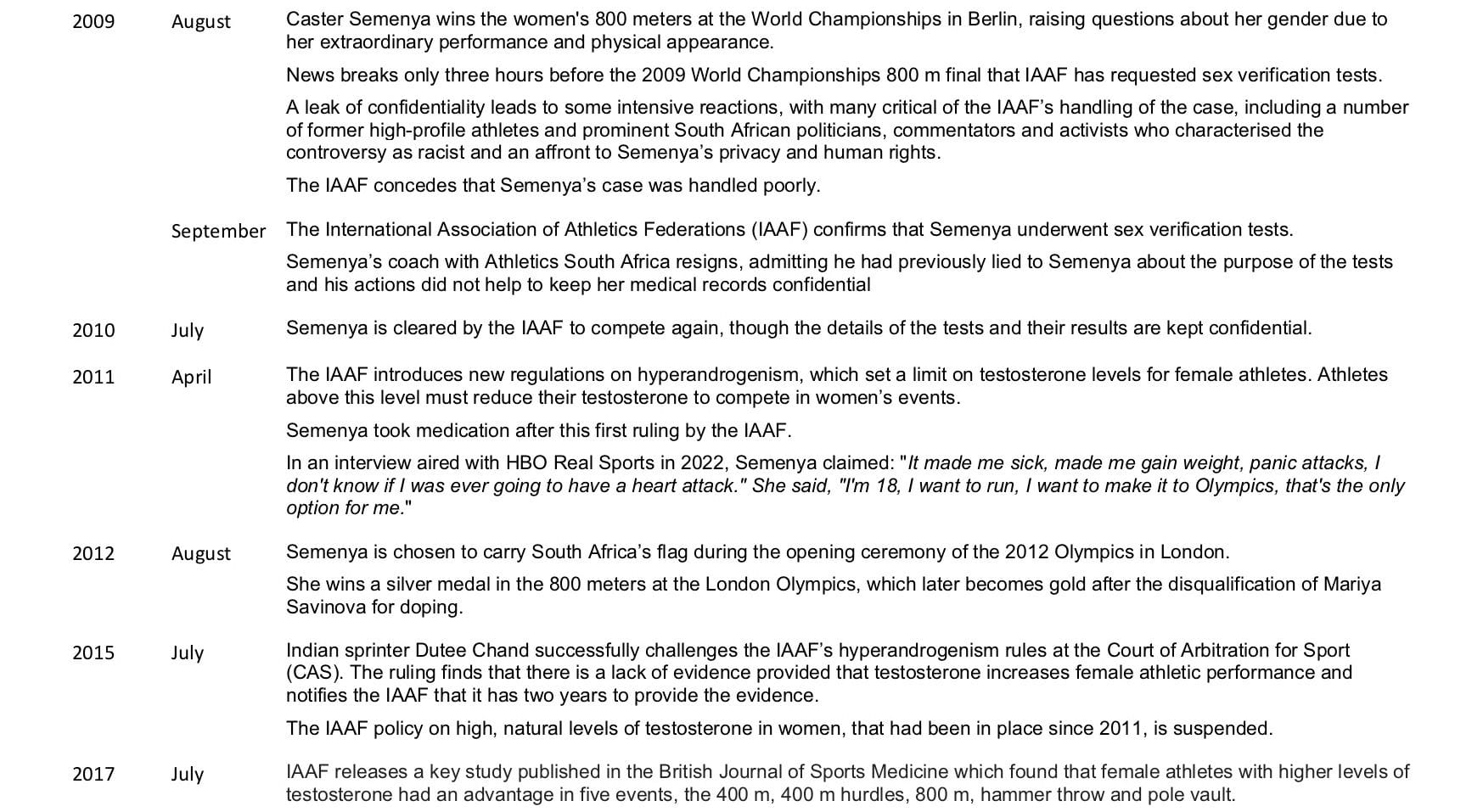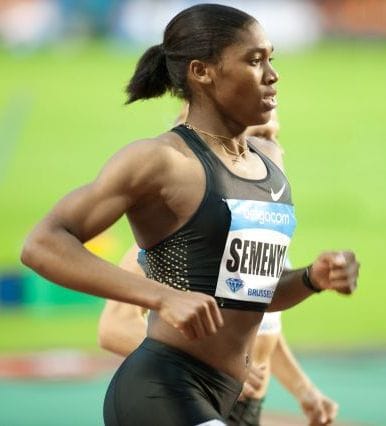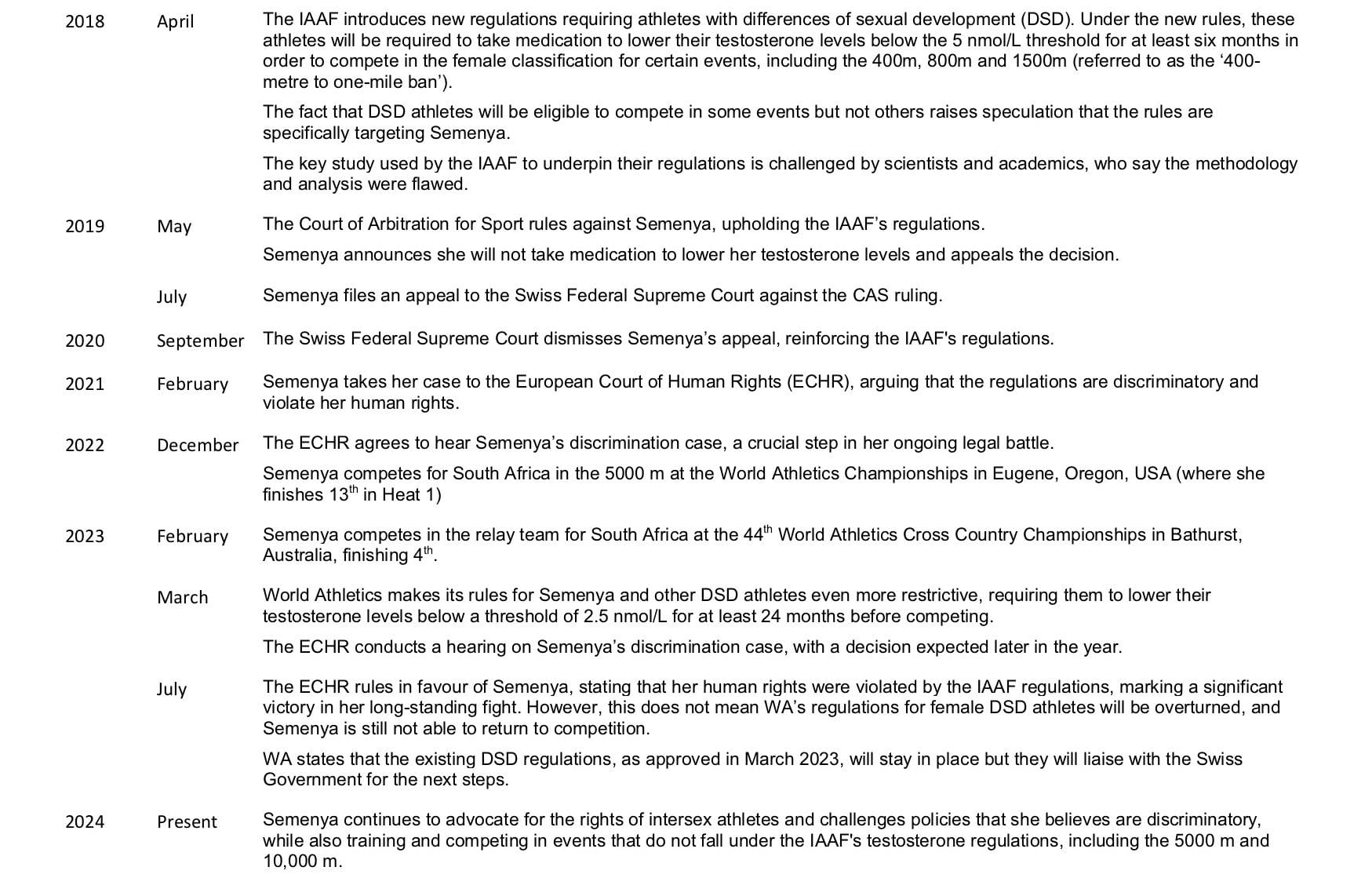Caster Semenya vs World Athletics: A synopsis
)
Image: Caster Semenya at the 2018 African Athletics Championships
The controversy between Caster Semenya and Sebastian Coe is one of the most contentious debates in modern athletics.
The dispute highlights the complex interplay between biological sex, gender identity and athletic performance. It flags a number of ethical and scientific questions.
Caster Semenya
Caster Semenya is a 2 x Olympic Champion 800 m (2012 London, 2016 Rio), 3 x World Champion 800 m (2009 Berlin, 2011 Daegu, 2017 London) and 1 x World Championships Bronze Medallist 1500 m (2017 London). She has an 800 m personal best of 1:54.25 30 (June 2018 Paris). For the full Honours Summary and world performances of Caster Semenya, visit World Athletics Profiles – Caster Semenya
Semenya, a South African middle-distance runner, rose to international prominence with her victory in the 800 metres at the 2009 World Championships. Almost immediately, her success became a focal point for controversy. Questions about her gender arose due to her rapid improvement and muscular physique, leading to invasive sex verification tests. These tests revealed that Semenya has differences of sexual development (DSD), a condition that results in higher levels of naturally occurring testosterone. DSD is defined as variations in reproductive anatomy, chromosome patterns or other traits that may not align with typical binary definitions of female or male.
Sebastian Coe
Sebastian Coe, a former Olympic champion and the President of World Athletics (formerly the International Association of Athletics Federations, IAAF), has been a central figure in the regulation of athletes with DSD. Coe and World Athletics have argued that elevated testosterone levels confer a significant competitive advantage in events ranging from 400 meters to one mile. This perspective led to the implementation of regulations in 2018 that require athletes with DSD to lower their testosterone levels to compete in these events.
World Athletic regulations for female DSD athletes
As at 2023, the regulations stipulate that athletes with DSD must reduce their testosterone levels below 2.4 nmol/L for at least 24 months prior to competing and maintain these levels continuously. These measures can be achieved through medication, surgery or other means. Semenya, however, has consistently refused to comply with these regulations, arguing that they are discriminatory and violate her human rights.
Semenya's refusal to undergo hormone treatment has led to her exclusion from competing in her favoured event, the 800 metres. She has challenged these regulations through various legal avenues, including the Court of Arbitration for Sport (CAS) and the Swiss Federal Supreme Court. In 2019, the CAS ruled in favour of World Athletics, stating that the regulations were necessary to ensure fair competition. The Swiss Federal Supreme Court upheld this decision in 2020.
A balancing act between inclusivity and fairness
Let’s be clear here. Semenya is not a transgender athlete, despite the media often conflating DSD and transgender status. WA accepts female DSD athletes like Semenya as females. World Athletics excludes female DSD athletes on the basis that their naturally occurring high testosterone levels gives them an unfair advantage over other female competitors. Semenya hasn’t cheated in any way nor done anything wrong. She just happens to have been born with a body that may produce substantially more testosterone than her rivals.
Supporters of Semenya argue that the regulations are inherently discriminatory, targeting women with naturally high testosterone levels while ignoring the diversity of human biology. They contend that forcing athletes to alter their natural physiology is unethical and infringes on their bodily autonomy. Furthermore, they argue that these regulations disproportionately affect women from the Global South, as DSD conditions are more frequently diagnosed in these regions.
On the other hand, Coe and proponents of the regulations argue that they are essential to maintain a level playing field. They assert that testosterone significantly enhances performance, particularly in middle-distance running, and that athletes with DSD possess an unfair advantage over their competitors. The goal, according to Coe, is not to exclude anyone but to ensure that competition remains fair for all female athletes.
The intersection of medicine with philosophy
An article was published in March 2024 by a highly respected group of Melbourne-based philosophers, Hilary Bowman and Julian Savulescu, and medical practitioners, Michele O'Connell and Andrew Sinclair: World Athletics regulations unfairly affect female athletes with differences in sex development. It unpacks three central points in the debate around athletes with DSD in elite sports:
- The evidence provided for whether there is a substantial mean difference in performance between female athletes with a DSD and those without (an advantage)
- Whether this substantial mean difference in performance (if it exists) is conceptually and philosophically relevant to the process of categorising elite athletes (and, thus, whether it is an unfair advantage)
- Whether the requirements of WA are an appropriate response to an unfair advantage.
The authors conclude that the WA regulations fail to be supported on all three of the above counts:
“We do not believe these regulations restricting the participation of female athletes with a DSD are evidence-based, ethically justified, or an appropriate response. There are not good reasons to support them.”
Following the 2023 European Court of Human Rights (ECHR) ruling in favour of Semenya, World Athletics committed to liaising with the Swiss Government on next steps. Ongoing dialogue is crucial for the development of inclusive and equitable sporting practices. There is no doubt that the resolution of this dispute will have lasting implications for the future of athletics and how gender is positioned in sports.
Conclusion
The Semenya-Coe controversy forces us to confront uncomfortable questions about the nature of gender, the definition of fairness and the rights of athletes. There are no easy answers.
---
Image: Caster Semenya at the 2010 Memorial Van Damme, Brussels, Belgium
Timeline of Caster Semenya’s Battle on Intersex and Sport

---
Image credits
Title: Caster Semenya at the 2018 African Athletics Championships. Attribution: Bob Ramsak, CC BY-SA 4.0, via Wikimedia Commons
Title: Caster Semenya at the 2010 Memorial Van Damme, Brussels, Belgium. Attribution: Tab59 from Düsseldorf, Allemagne, CC BY-SA 2.0, via Wikimedia Commons
References
Bowman-Smart H, Savulescu J, O’Connell M & Sinclair A (2024) World Athletics regulations unfairly affect female athletes with differences in sex development. Journal of the Philosophy of Sport, 51(1), 29–53, DOI: 10.1080/00948705.2024.2316294 https://doi.org/10.1080/00948705.2024.2316294
Bermon S & Garnier PY (2017). Serum androgen levels and their relation to performance in track and field: Mass spectrometry results from 2127 observations in male and female elite athletes. British Journal of Sports Medicine, Online first release (3 July 2017). https://pubmed.ncbi.nlm.nih.gov/28673896/. Full article download available here: https://www.iaaf.org/download/download?filename=66958208-d45a-480b-995c-cbdf36ca5af2.pdf&urlSlug=bermon-et-al-bjsm-2017
Bull A (2018). Caster Semenya and the IAAF: If the science is wrong, the ruling is wrong. The Guardian. https://www.theguardian.com/sport/blog/2018/may/01/caster-semenya-iaaf-science-athletics-testosterone
Burfoot A (2019). The world is watching: Caster Semenya vs IAAF. Letsrun.com https://www.letsrun.com/news/2019/04/the-whole-world-is-watching-caster-semenya-vs-iaaf/
Court of Arbitration for Sport. CAS 2018/O/5794 Caster Semenya v. International Association of Athletics Federations. CAS 2018/O/5798 Athletics South Africa v. International Association of Athletics Federations. https://www.tas-cas.org/fileadmin/user_upload/CAS_Award_-_redacted_-_Semenya_ASA_IAAF.pdf
Franklin S, Ospina Betancurt J, & Camporesi S (2018). New eligibility regulations for female athletes with “Differences of Sex Differentiation”. (Blog). British Journal of Sports Medicine. https://blogs.bmj.com/bjsm/2018/04/26/new-eligibility-regulations-for-female-athletes-with-differences-of-sex-differentiation/
Imray G (2021). Explainer: What exactly are track’s testosterone rules? Associated Press. https://apnews.com/article/2020-tokyo-olympics-track-and-field-sports-africa-switzerland-olympic-team-a704fcfb0f00918eadbb6cac39185a8d
Pingue F (2022). Semenya offered to show her body to officials to prove she was female. Reuters. https://www.reuters.com/lifestyle/sports/semenya-offered-show-her-body-officials-prove-she-was-female-2022-05-24/
Reid G & Worden M (2023). Caster Semenya wone her case, but not the right to compete. Human Rights Watch. https://www.hrw.org/news/2023/07/18/caster-semenya-won-her-case-not-right-compete
Wikipedia. Caster Semenya. https://en.wikipedia.org/wiki/Caster_Semenya
World Athletics (4 July 2017). Levelling the playing field in female sport: New research published in the British Journal of Sports Medicine. (Press release). https://worldathletics.org/news/press-release/hyperandrogenism-research
World Athletics. (8 May 2019). IAAF publishes briefing notes and Q&A on female eligibility regulations. (Press release). https://worldathletics.org/news/press-release/questions-answers-iaaf-female-eligibility-reg
| Tags:Famous athletesHeart Health for AthletesHH4A |



)